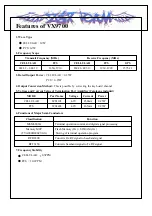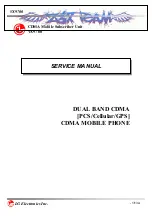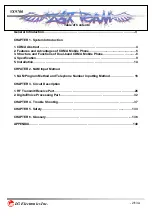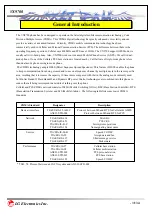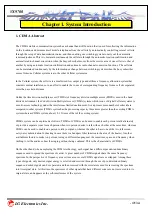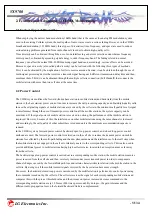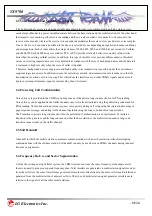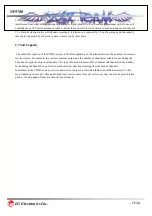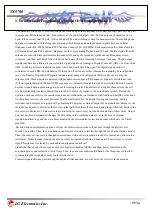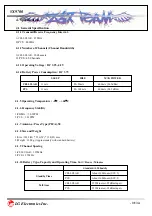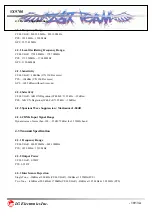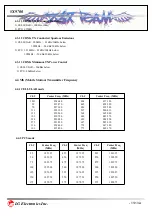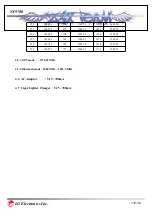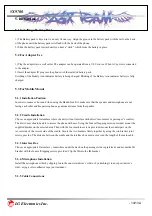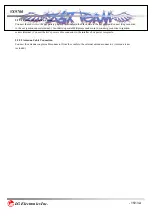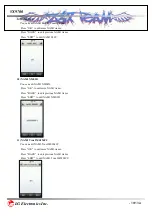
- 6/132-
LG Electronics Inc.
2.3 Voice Encoder and Variable Data Speed
encoder algorithm having power variable data rate between the base station and the mobile station. On the other hand,
the transmit voice encoder performs voice sampling and then, creates encoded voice packets to be sent out to the
receive voice encoder, whereas the receive voice encoder demodulates the received voice packets into voice samples.
One of the two voice encoders described in the above is selected for use depending on inputted automatic conditions
and message/data; both of them utilize four-stage frames of 9600, 4800, 2400, and 1200 bits per second for Cellular
and 14400,7200,3600,1800 bits per second for PCS, so PCS provide relatively better voice quality (almost twice
better than the existing cellular system). In addition, this type of variable voice encoder utilizes adaptive threshold
values on selecting required data rate. It is adjusted in accordance with the size of background noise and the data rate
is increased to high rate only when the voice of caller is inputted.
Therefore, background noise is suppressed and high-quality voice transmission is possible under the environment
experiencing serious noise. In addition, in case the caller does not talk, data transmission rate is reduced so that the
transmission is carried out in low energy. This will reduce the interference on other CDMA signals and as a result,
improve system performance (capacity increased by about two times).
2.4 Protecting Call Confidentiality
Voice privacy is provided in the CDMA system by means of the private long code mask used for PN spreading.
Voice privacy can be applied on the traffic channels only. All calls are initiated using the public long code mask for
PN spreading. The mobile station user may request voice privacy during call setup using the origination message or
page response message, and during traffic channel operation using the long code transition request order.
The Transition to private long code mask will not be performed if authentication is not performed. To initiate a
transition to the private or public long code mask, either the base station or the mobile station sends a long code
transition request order on the traffic channel.
2.5 Soft Handoff
A handoff in which the mobile station commences communications with a new base station without interrupting
communications with the old base station. Soft handoff can only be used between CDMA channels having identical
frequency assignments.
2.6 Frequency Re-Use and Sector Segmentation
Unlike the existing analog Cellular system, the CDMA system can reuse the same frequency at the adjacent cell.
there is no need to prepare a separate frequency plan. Total interference generated on mobile station signals received
from the cell site is the sum of interference generated from other mobile stations in the same cell site and interference
generated from the mobile station of adjacent cell site. That is, each mobile station signal generates interference in
relation to the signals of all the other mobile stations.
Z3X-BOX.COM
Summary of Contents for VX9700
Page 26: ... 25 132 LG Electronics Inc VX9700 28 Powering Down Restart Z 3 X B O X C O M ...
Page 59: ... 58 132 LG Electronics Inc VX9700 Waveform Waveform F106 pin2 DP2 pin2 Z 3 X B O X C O M ...
Page 154: ...CON104 Z 3 X B O X C O M ...
Page 156: ...Z 3 X B O X C O M ...
Page 159: ...CON809 SW101 SW102 Z 3 X B O X C O M ...
Page 160: ...CON808 Z 3 X B O X C O M ...
Page 162: ...CON809 SW104 Z 3 X B O X C O M ...
Page 163: ...CON808 Z 3 X B O X C O M ...
Page 165: ...SW1 CON2 Z 3 X B O X C O M ...
Page 166: ...CON1 Z 3 X B O X C O M ...
Page 167: ... 15 132 LG Electronics Inc VX9700 Appendix 3 Part List VX9700 Part List Z 3 X B O X C O M ...
Page 168: ... 16 132 LG Electronics Inc VX9700 Appendix 4 Components Layout Z 3 X B O X C O M ...
Page 174: ...Z 3 X B O X C O M ...

